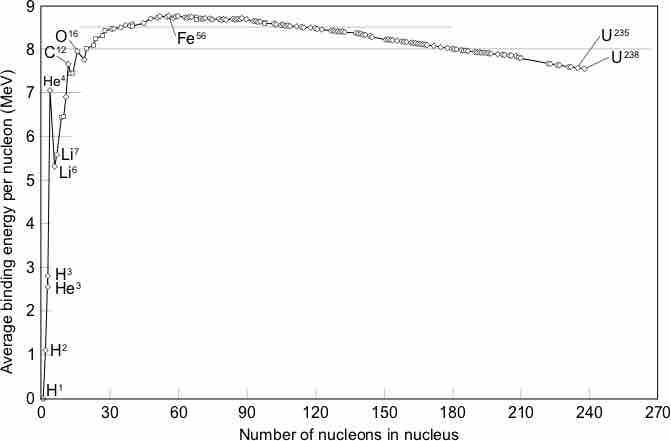Binding Energy
Nuclear binding energy is the energy required to split a nucleus of an atom into its component parts: protons and neutrons, or, collectively, the nucleons. The binding energy of nuclei is always a positive number, since all nuclei require net energy to separate them into individual protons and neutrons.
Mass Defect
Nuclear binding energy accounts for a noticeable difference between the actual mass of an atom's nucleus and its expected mass based on the sum of the masses of its non-bound components.
Recall that energy (E) and mass (m) are related by the equation:
Here, c is the speed of light. In the case of nuclei, the binding energy is so great that it accounts for a significant amount of mass.
The actual mass is always less than the sum of the individual masses of the constituent protons and neutrons because energy is removed when when the nucleus is formed. This energy has mass, which is removed from the total mass of the original particles. This mass, known as the mass defect, is missing in the resulting nucleus and represents the energy released when the nucleus is formed.
Mass defect (Md) can be calculated as the difference between observed atomic mass (mo) and that expected from the combined masses of its protons (mp, each proton having a mass of 1.00728 amu) and neutrons (mn, 1.00867 amu):
Nuclear Binding Energy
Once mass defect is known, nuclear binding energy can be calculated by converting that mass to energy by using E=mc2. Mass must be in units of kg.
Once this energy, which is a quantity of joules for one nucleus, is known, it can be scaled into per-nucleon and per-mole quantities. To convert to joules/mole, simply multiply by Avogadro's number. To convert to joules per nucleon, simply divide by the number of nucleons.
Nuclear binding energy can also apply to situations when the nucleus splits into fragments composed of more than one nucleon; in these cases, the binding energies for the fragments, as compared to the whole, may be either positive or negative, depending on where the parent nucleus and the daughter fragments fall on the nuclear binding energy curve. If new binding energy is available when light nuclei fuse, or when heavy nuclei split, either of these processes result in the release of the binding energy. This energy—available as nuclear energy—can be used to produce nuclear power or build nuclear weapons. When a large nucleus splits into pieces, excess energy is emitted as photons, or gamma rays, and as kinetic energy, as a number of different particles are ejected.
Nuclear binding energy is also used to determine whether fission or fusion will be a favorable process. For elements lighter than iron-56, fusion will release energy because the nuclear binding energy increases with increasing mass. Elements heavier than iron-56 will generally release energy upon fission, as the lighter elements produced contain greater nuclear binding energy. As such, there is a peak at iron-56 on the nuclear binding energy curve.

Nuclear binding energy curve
This graph shows the nuclear binding energy (in MeV) per nucleon as a function of the number of nucleons in the nucleus. Notice that iron-56 has the most binding energy per nucleon, making it the most stable nucleus.
The rationale for this peak in binding energy is the interplay between the coulombic repulsion of the protons in the nucleus, because like charges repel each other, and the strong nuclear force, or strong force. The strong force is what holds protons and neutrons together at short distances. As the size of the nucleus increases, the strong nuclear force is only felt between nucleons that are close together, while the coulombic repulsion continues to be felt throughout the nucleus; this leads to instability and hence the radioactivity and fissile nature of the heavier elements.
Example
Calculate the average binding energy per mole of a U-235 isotope. Show your answer in kJ/mole.
First, you must calculate the mass defect. U-235 has 92 protons, 143 neutrons, and has an observed mass of 235.04393 amu.
Md = (92(1.00728 amu)+143(1.00867 amu)) - 235.04393 amu
Md = 1.86564 amu
Calculate the mass in kg:
1.86564 amu x
Now calculate the energy:
E = mc2
E = 3.09797 x 10-27 kg x (2.99792458 x 108
E =2.7843 x 10-10 J
Now convert to kJ per mole: